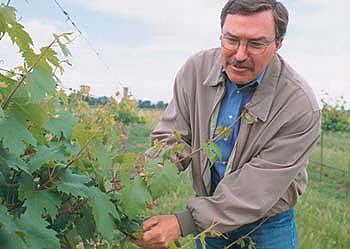All Issues
Breeding and genetics key to stemming Pierce's disease
Publication Information
California Agriculture 57(3):69-70.
Published July 01, 2003
PDF | Citation | Permissions
Full text
Classical breeding combined with modern genesplicing techniques may be the key to maintaining and creating grape hybrids resistant to Pierce's disease, UC scientists told a workshop for North Coast vintners. The workshop, held April 22 in Napa and hosted by UC Riverside's College of Natural and Agricultural Sciences, was designed to give local growers and vintners the latest information on the deadly plant disease.
While the nonnative glassy-winged sharpshooter (GWSS) — which transmits the Pierce's disease (PD) pathogen Xylella fastidiosa — has not become established in northern premium wine-grape growing areas, it has made inroads and damaged several hundred acres of vines in Southern California. This voracious insect — a highly efficient vector for the disease — has spread northward from Southern California to Kern and Tulare counties.
UC Davis geneticist Andrew Walker is breeding varieties to confer disease resistance without losing flavor characteristics suitable for the table-grape, raisin and wine industries. However, he estimates it may be 15 to 20 years before disease-resistant commercial wine-grape varieties are available.
Scientists typically search for disease-resistance characteristics in wild but related species. Walker and his colleagues are using four wild species that show PD-resistance, all from the southeastern United States. They are also experimenting with dozens of resistant selections from breeders there.
UC Davis geneticist Andrew Walker and colleagues are studying the grape genome, in order to identify genes that confer resistance to Pierce's disease and other grape maladies.
"Breeding grapes can be frustrating," Walker says. "Wild species are often hard to classify; they are hybrid forms that can vary between parental extremes. For instance, the same species could have members that are very resistant or very susceptible to Pierce's disease. We can not select parents for breeding without extensive pretesting to ensure they have the high levels of resistance we need."
The process of identifying genes for resistance to Pierce's disease could be shortened by using gene-mapping techniques similar to those used to map the human genome. It may be many years before the grape genome is completely mapped, but Walker and colleagues have begun to build basic maps that will help them find genes that confer resistance, as well as identify better hybrids for breeding purposes.
However, Walker warned: "You can isolate a desirable gene from one grape species and splice it into the chromosome of another, but you currently have little control over where the new gene is placed on a chromosome, or how it is expressed. In many ways, gene-splicing techniques involve as much trial-and-error as traditional breeding techniques."
UC Riverside plant pathologist Donald Cooksey also emphasized the variety of genetic strains of Pierce's disease. Some strains of X. fastidiosa can cause disease on grapes, almonds and alfalfa, while others attack citrus, coffee and oleander specifically. Xylella is a specialized pathogen, growing only in the plant xylem and insect mouthparts. Strategies to prevent disease include techniques to prevent establishment of Xylella in the sharpshooter mouthparts and the use of harmless, naturally occurring endophytic bacteria to compete with Xylella for colonization of grapevines.
Damage to grapevines in the Napa and Sonoma valleys tends to be concentrated at the edges of vineyards, UC Berkeley entomologist Alexander Purcell told the workshop. With the introduction of GWSS, there could be transmission from vine to vine, and the possibility of an exponential growth in numbers of infected plants.
Sponsors of the conference included UC agricultural departments and centers, UC Cooperative Extension, the North Coast Pierce's Disease Task Force, and a variety of vintners and agricultural suppliers.





